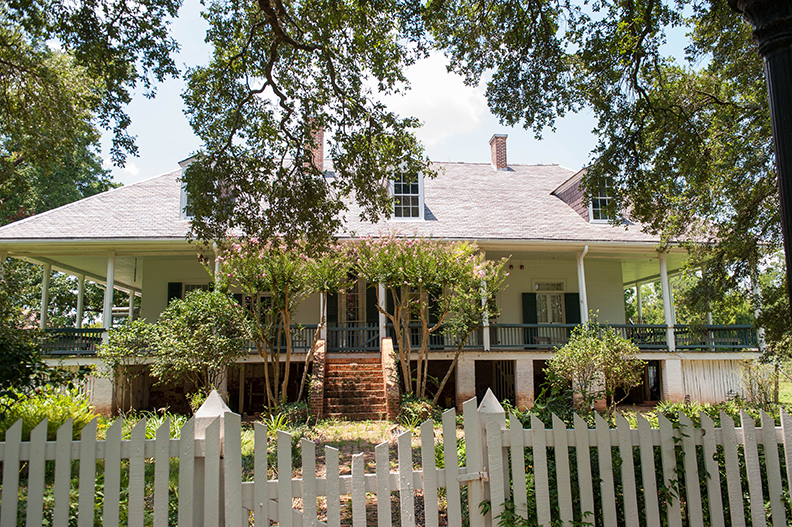Explore Civil War Sites in Central Louisiana
Learn about the lasting effects of the Civil War on Central Louisiana with a visit to historical sites in Alexandria, Natchitoches and beyond.
The Red River, which flows across Central Louisiana, played a strategic role in the Civil War. Learn about its impact at Forts Randolph and Buhlow State Historic Site and other history-packed locations in Central Louisiana.
Forts Randolph and Buhlow State Historic Site
History of Forts Randolph and Buhlow
Imagine having to grow your own food, sleep in a tent and wait anxiously for battles that never came. That was the life of Confederate soldiers at Forts Randolph and Buhlow, located on the Red River in downtown Pineville.
After the Battle of Mansfield in 1864 delayed the Union’s advance into western Louisiana, two earthwork forts were built on the banks of the Red River at Alexandria. The Confederates expected these forts to stop future Union attacks in North Louisiana, but the Confederate States Army surrendered shortly after the forts’ completion, and the site never saw action.
While the forts were under construction, Union troops were making their way down the Red River to meet up with additional forces near the Mississippi River. But the river was unusually low that spring, and the Union ships couldn’t get past Alexandria safely with Confederate snipers located along the river banks.
Col. Joseph Bailey suggested building a dam that would raise the water high enough to float the fleet over the rapids of the Red River. With 3,000 soldiers, two dams were built in only eight days. Three days later, all the boats had safely passed the rapids and falls and continued down the river. Bailey’s Dam is considered one of the greatest engineering feats of the Civil War.
Forts Randolph and Buhlow were placed on the National Register of Historic Places in 1981.
What to Know About Visiting Forts Randolph and Buhlow State Historic Site
Today, a beautiful elevated boardwalk wraps around the earthworks and offers a view of the Bailey's Dam site at the historic area. The boardwalk is nice and shaded, so you won’t get too hot on a walk around the site.
If you can’t beat the heat, cool off in the visitor center, which features exhibits on the Red River Campaign and holds many interesting artifacts found in the area, including bits of uniforms, snuff cans and musket balls. Discover a cotton-combing machine, exhibits on how rations were stretched with local roots and native fruits and nuts, cannon replicas and multimedia displays.
Because the soldiers stationed at Forts Randolph and Buhlow didn’t participate in any battles, they had considerable time on their hands. Whittling was a favorite pastime — whether chipping shavings from a chunk of wood or creating tools and game pieces — and demonstrations are held often, with park staff using equipment the soldiers would have used.
In addition to the usual encampment activities, the soldiers cultivated a vegetable garden much like other established encampments. The site carries on this tradition thanks to the Rotary Club of Pineville, a partnership that gives back to the community and enables the site to demonstrate the daily life of a Civil War soldier. In addition to self-guided tours, visitors can sometimes see the garden highlighted during campfire cooking demonstrations.

The boardwalk at Forts Randolph and Buhlow State Historic Site

Cannon at Forts Randolph and Buhlow State Historic Site

Frogmore Cotton Plantation & Gins

Oakland Plantation
Louisiana History Museum
Nearby, the Louisiana History Museum features rotating exhibits on the development and history of Alexandria, Rapides Parish and Central Louisiana. Admission is free, and exhibits explore the state’s important industries, famous figures and more.
Alexandria National Cemetery
Alexandria National Cemetery was established in 1867 as a final resting place for Union soldiers who perished in Louisiana during the Civil War. It's difficult not to be moved by the long rows of uniform white headstones that stud the lawn. The cemetery was placed on the National Register of Historic Places in 1997.
Frogmore Cotton Plantation and Gins
This working cotton plantation in Concordia Parish was the site of an encampment and skirmish for 1,776 Union troops led by Col. Bernard Farrar, including the Illinois infantry and heavy artillery. The plantation was part of the Natchez District, and many plantation owners in this region were Union rather than Confederate sympathizers. Take the "Plantation Civil War: Challenges and Changes" tour to learn about the many effects the war and Army occupation had on plantation owners, enslaved people and the women and children left behind.
Cane River Creole National Historical Park
In Natchitoches Parish, Cane River Creole National Historical Park encompasses several sites that provide perspective on the Civil War era and the lasting impacts of slavery and Reconstruction. Learn about the struggles and resilience of the region’s Creole communities and enslaved people at Oakland Plantation, Magnolia Plantation and Melrose Plantation, where tours offer glimpses of life before, during and after the Civil War.
Grand Ecore Visitor Center
About 4 miles north of Natchitoches, Grand Ecore Visitor Center served as an important staging point and supply depot for the Union Army and Navy during the Red River campaign. Sitting high on a bluff overlooking the Red River, it held a strategic position and was even utilized by Confederate forces, both before and after the spring 1864 invasion. Today, the Grand Ecore Visitor Center offers excellent exhibits on the site’s history and importance, as well as spectacular views of the river.
Learn more about the Civil War in North Louisiana and South Louisiana.


